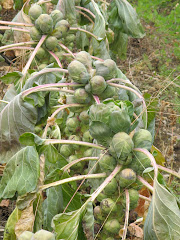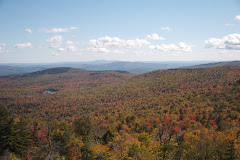
This afternoon we brought the cows in for the winter. The day was perfect: cold and windy, clouds shifting across a grey-blue November sky, the light hard and golden on the pastures. We'd been inside all morning, and it felt great to get out into the brisk today and use our muscles. To bring the cows back, we had to run them from the pasture they were just on, about a mile up the road, across five pastures and two roads. This involved a rather intricate fencing design, involving lanes for them to follow through some pastures, two holding pens where we could regroup them before road crossings, and a total of 11 people, herding, luring, road-blocking, and gate-opening.
After an hour and a half putting up fencing, we gathered at the farm to make a plan, split up, and took our positions. The move was easy. It was a gorgeous day to be running behind a herd of 12 cows, across a swath of fields that I have come to know well over the course of a month. The only escapee was one of the frisky calves, at a tricky corner, but we calmly herded her back into the lane and into the cows' permanent winter residence. They'll be living in a paddock adjacent to the barn, with plenty of good hay and shelter if they want it, until the beginning of May.
The afternoon ended on a more solemn note, when the trailer arrived to take the bull back. We rented a bull to breed our cows for 45 days, and his stay with the herd is over. The man in charge of the trailer was harsh and rough, hitting the cows and the bull with fiberglass fenceposts and yelling at them sternly. I don't know if this is common practice, but it didn't sit well with me. At one point, Pride, our sweet dairy cow, was right in the middle of the action, walking calmly into the trailer where we were trying to get the bull. She is used to being handled, and, to my knowledge, not used to harsh treatment.
All of my own dealings with the animals since I've been at Maggie's have been calm, quiet, and gentle. I've watched the farmers here herd cows, catch sheep, and work horses, always with respect, always kindly, and always with dominance and strength. I am no expert on animal handling, and getting a 1200-pound bull into a trailer is not an easy task. But it was hard to watch such gentle, sturdy creatures being treated in a way that, to me, seemed disrespectful.
After the bull was gone and the herd calmed down a bit, my first reaction was to go to Pride and comfort her. Who knows if she was scared or traumatized. She hasn't spent any time with the herd, so for her, it was all new. I didn't realize until today how much I've come to love her. She is sweet and patient, sometimes feisty. She has her own personality. She never stands still when you're milking her. She gets lonely. And sometimes she nuzzles me with her long face and big brown eyes. These are all things I love about her.
A month and a half ago, I didn't know these cows. Now I feel protective of them, especially Pride, who, this week, I am milking every day. I love hanging out with the herd, listening to them eat, getting to know each one with their distinctive quirks. I didn't realize how much I would come to love these animals and appreciate time spent with them.
Is it irrational to love a sweet, 4-year old Jersey dairy cow? Or an orange cat who lets me pick him up and purrs in my arms at least five times a day? Is it irrational to love a ram lamb named Lincoln with the softest fleece on the sides of his ears, who nibbles my sleeves when I go out to say hello to him in the pasture? I don't know. I don't think so. What I do now is that our relationships with domestic animals are not as simple as I once thought. Every day I learn something new about an animal. Every day I have a moment, walking Ruby Star out to pasture, or leaning against Pride's warm side as I milk her, when I know that this daily contact with non-human creatures is changing the way I see the world. I think it's a change worth paying attention to.


























































































































